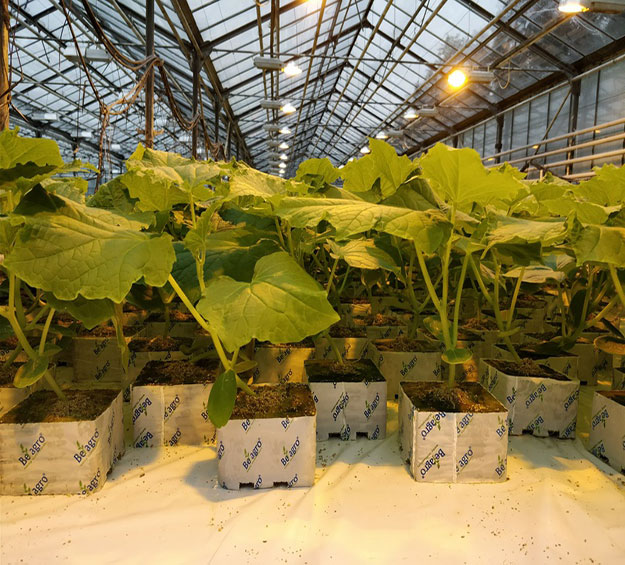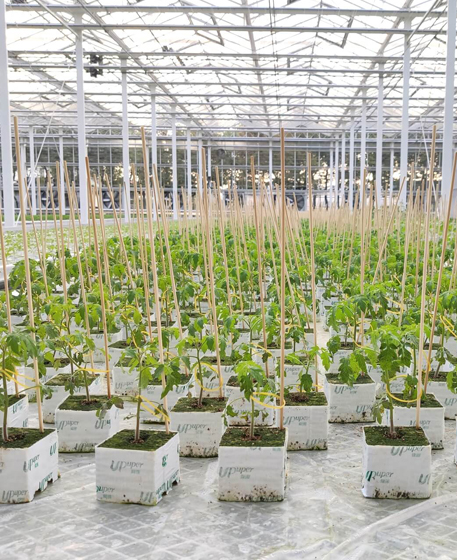Rockwool cubes, a lightweight hydroponic substrate is made from spinning molten basaltic rock into fine fibers which are then formed into a range of cubes, blocks, growing slabs and granular products.
How do Rockwool Cubes Benefit Plant Growth in Hydroponic Systems?
Rockwool cubes offer several benefits for plant growth in hydroponic systems. As an inert and sterile growing medium, Rockwool provides excellent support for seed germination and root development. Its structure promotes efficient air and water retention, ensuring optimal moisture levels for plants. The fibrous nature of Rockwool cubes also allows for good aeration and drainage, preventing overwatering and root suffocation. The cubes are pH-neutral, providing a stable environment for nutrient absorption. Moreover, Rockwool's insulation properties protect plant roots from temperature extremes.
What Are the Ideal Conditions for Germinating Seeds in Rockwool Cubes?
The seeds that germinate in Rockwool cubes require specific conditions to ensure successful and healthy seedling development:
Pre soaking: Before placing the seeds in rock wool cubes, it is beneficial to pre soak the cubes in pH balanced water.
Seed placement: Place the seeds in the center of a pre moistened rockwool cube at the recommended depth.
Optimal temperature: Maintain a consistent temperature range for germination, typically between 70 ° F to 80 ° F (21 ° C to 27 ° C).
Humidity control: During the germination stage, cover the seeds with a humidity dome or place the cubes in a covered tray to ensure a high humidity environment.
Light: Although light is not essential during the germination stage, providing low intensity light sources is beneficial for even germination. Once the seedlings appear, they need to transition to appropriate lighting conditions for photosynthesis.
Adequate moisture: Keep the moisture level of the rockwool cube consistent without standing water.
PH monitoring: Regularly monitor and adjust the pH value of water used for soaking and irrigating rockwool cubes. Maintaining a pH range of 5.5 to 6.5 is usually suitable for most plants.
Ventilation: Ensure appropriate ventilation to prevent fungal problems and promote healthy growth of seedlings. Good air circulation helps prevent decay and encourages strong and sturdy seedlings.
By providing you with these conditions through UPuper, you can create an environment conducive to the successful germination of Rockwood cube seeds. As the seedlings develop, transplant them into a hydroponic system or selected growth medium to continue growing under optimized conditions.

Can Rockwool Cubes Be Reused, and How Should They Be Properly Sterilized?
The rockwool cubes of UPuper® can be reused through appropriate disinfection procedures. After a growth cycle, the Rockwool cube must be cleaned and disinfected to eliminate any residual plant debris, pathogens, or residues that may affect the next crop.
To disinfect Rockwool cubes, first thoroughly rinse them to remove any loose substances. Immerse the cube in a hydrogen peroxide solution or a mild bleaching solution to ensure complete saturation. Soak the cube long enough, usually around 24 hours, to effectively disinfect the material. After sterilization, thoroughly rinse the Rockwool cube with clean water to remove any residual sterilization solution. Proper sterilization helps to maintain a clean and disease-free environment for new planting, ensuring optimal conditions for healthy root development in reused rock wool cubes.
What pH and EC Levels Are Suitable for Rockwool Cube Applications in Hydroponics?
In hydroponic systems using Rockwool cubes as a growing medium, maintaining specific pH and Electrical Conductivity (EC) levels is crucial for optimal nutrient absorption and plant growth.
The recommended pH range for Rockwool cube applications typically falls between 5.5 to 6.5. This pH range ensures that essential nutrients are available to plants in their most absorbable forms. Regarding EC levels, it's essential to monitor and adjust the nutrient concentration in the hydroponic solution based on the plant's growth stage and specific crop requirements. Generally, EC levels for Rockwool-grown crops range from 1.2 to 2.5 mS/cm (millisiemens per centimeter).
Regular monitoring and adjustment of pH and EC levels contribute to a well-balanced nutrient solution, promoting healthy root development and robust plant growth in hydroponic systems utilizing Rockwool cubes.
How Should Rockwool Cubes Be Prepped and Conditioned Before Planting?
Preparing and conditioning rockwool cubes before planting plants is crucial for creating the optimal environment for seed germination or transplantation. UPuper® provides you with these suggested steps:
Soaking: First, soak the rockwool blocks in pH balanced water to ensure that they are completely saturated.
PH balance: Check and adjust the pH value of the soaking water to within the recommended range of 5.5 to 6.5.
Seed placement or transplantation: If the seed is germinating, place it at the center of the Rockwool cube to the recommended depth.
Humidity dome: Cover the rockwool cube with a humidity dome or place it in a covered tray.
Temperature control: Keep the temperature of the rock wool cube consistent, preferably between 70 ° F to 80 ° F (21 ° C to 27 ° C).
Ventilation: Ensure appropriate ventilation to prevent excessive humidity and reduce the risk of fungal problems.
Lighting: Although not important in the initial stage, providing low intensity light can promote uniform germination or help transplant to adapt to new environments.
Moisture management: Regularly monitor and adjust the moisture level in rockwool cubes to prevent excessive moisture or dryness.

What Types of Plants Thrive Best in Rockwool Cube Growing Media?
Herbs: Culinary herbs such as basil, cilantro, parsley, and mint
Lettuce and Leafy Greens: Varieties of lettuce, spinach, kale
Flowering Plants: Plants that produce vibrant flowers, such as geraniums, petunias, and marigolds.
Tomatoes and Peppers: These fruiting plants do well in Rockwool cubes, providing a controlled and nutrient-rich environment that supports robust growth and fruit production.
Strawberries: Rockwool cubes offer excellent support for strawberry plants, allowing for efficient nutrient delivery and proper aeration, resulting in healthy berry production.
Cucumbers: Cucumber plants, with their sprawling vines and fruiting structures.
Microgreens: Rockwool cubes are well-suited for cultivating microgreens.
Ornamental Plants: Various ornamental plants, such as ferns, begonias, and orchids.
Are There Alternative Substrates or Growing Media Comparable to Rockwool Cubes?
Yes, there are other alternative substrates or growth media that are more suitable.
Coconut shell is a natural fiber extracted from coconut shell and is a popular substitute known for its water retention and ventilation properties.
Peat moss comes from decaying plant materials and is another choice for moisturizing and regulating acidity.
Pearlite and vermiculite are both mineral based media that provide ventilation and moisturizing effects.
Each alternative solution has its unique characteristics, and the selection usually depends on factors such as water retention, aeration, and specific requirements of the cultivated plant.

UPUPER rockwool cube is lightweight and non dispersing, which can reduce labor costs and intensity. Helps improve the labor environment and production efficiency. UPUPER rock wool substrate is produced on a fully automated production line, so customers will receive products with accurate dimensions and fast delivery times. UPUPER can meet the needs of different growers at different times.





